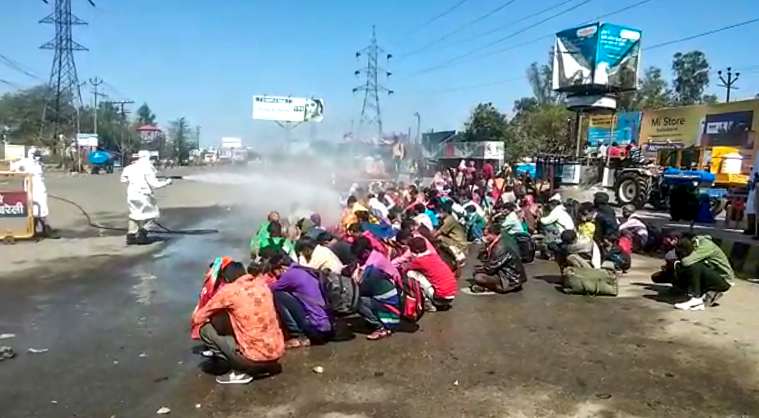Explained: Why disinfectant must not be sprayed on humans
Coronavirus (COVID-19): As the country prepares for some relaxations, the Health Ministry has issued a detailed advisory against spraying humans with disinfectants.
 Coronavirus (COVID-19): Workers are sprayed with disinfectant solution in Gujarat. (Express Photo: Bhupendra Rana)
Coronavirus (COVID-19): Workers are sprayed with disinfectant solution in Gujarat. (Express Photo: Bhupendra Rana)
Coronavirus (COVID-19): In the immediate aftermath of the nationwide lockdown being announced last month, when countless migrant workers started walking hundreds of kilometres in the hope of reaching their villages or towns, visuals emerged from various parts of the country, including Bareilly in UP, of migrants being sprayed with disinfectant solution.
As the country prepares for some relaxations and industries get ready to start functioning with strict conditions including housing labourers on the premises, the Health Ministry has issued a detailed advisory against spraying humans with disinfectants.
Read this story in Tamil, Bangla, Malayalam
What does the order say?
The order dated April 19 says, “Spraying of individuals or groups is NOT recommended under any circumstances. Spraying an individual or group with chemical disinfectants is physically and psychologically harmful. Even if a person is potentially exposed with the COVID-19 virus, spraying the external part of the body does not kill the virus that has entered your body. Also there is no scientific evidence to suggest that they are effective even in disinfecting the outer clothing/body in an effective manner.”
The advisory has been issued, officials say, to prevent a rerun when labourers start returning to industries that qualify for relaxation. Home Ministry guidelines require them to be housed on the premises but “disinfection” at entry is a very real danger.
📣 Express Explained is now on Telegram. Click here to join our channel (@ieexplained) and stay updated with the latest
 A screen grab shows healthcare workers, in protective suits, spray a solution on migrants before allowing them to enter the town of Bareilly, Monday, March 30, 2020. (PTI Photo)
A screen grab shows healthcare workers, in protective suits, spray a solution on migrants before allowing them to enter the town of Bareilly, Monday, March 30, 2020. (PTI Photo)
How is “disinfection” carried out?
Disinfection for the SARS-CoV2 virus is usually done using a solution of sodium hypochlorite, commonly known as bleach. It is a harsh chemical. “It (disnfectant) refers to substances applied on inanimate objects owing to their strong chemical properties. Chemical disinfectants are recommended for cleaning and disinfection only of frequently touched areas/surfaces by those who are suspected or confirmed to have COVID-19,” the advisory lays down.
What is the problem with spraying people with this solution?
It can be harmful. Besides, the act itself is pointless. This is because there is a specific time that the disinfectant takes to act on an area, and as per the disinfection protocol, any place that has been disinfected has to be kept shut overnight. “There are very clear norms for this. You disinfect with sodium hypochlorite and then the place remains closed overnight. If during that time anybody enters the place, regardless of whether that person is carrying the infection or not, the process has to be repeated,” explained a senior official of the National Centre for Disease Control.
Don’t miss from Explained | How COVID-19 is hurting the rupee’s exchange rate with other currencies
What are the possible harmful effects?
The solution of sodium hypochlorite is unstable and quickly breaks down to release chlorine. Chlorine can have several harmful effects, the Health Ministry said.
“Spraying of chlorine on individuals can lead to irritation of eyes and skin and potentially gastrointestinal effects such as nausea and vomiting. Inhalation of sodium hypochlorite can lead to irritation of mucous membranes to the nose, throat, respiratory tract and may also cause bronchospasm. Additionally use of such measures may in fact lead to a false sense of disinfection & safety and actually hamper public observance to hand washing and social distancing measures,” says the advisory.
Don’t miss these articles on Coronavirus from the Explained section:
‣ How coronavirus attacks, step by step
‣ Mask or no mask? Why the guidance has been shifting
‣ Besides a face cover, should I wear gloves when I go outdoors?
‣ How the Agra, Bhilwara and Pathanamthitta Covid-19 containment models differ
Photos
- 01
- 02
- 03
- 04
- 05





































